Carrot Plantain Purée (Homemade Baby Food)
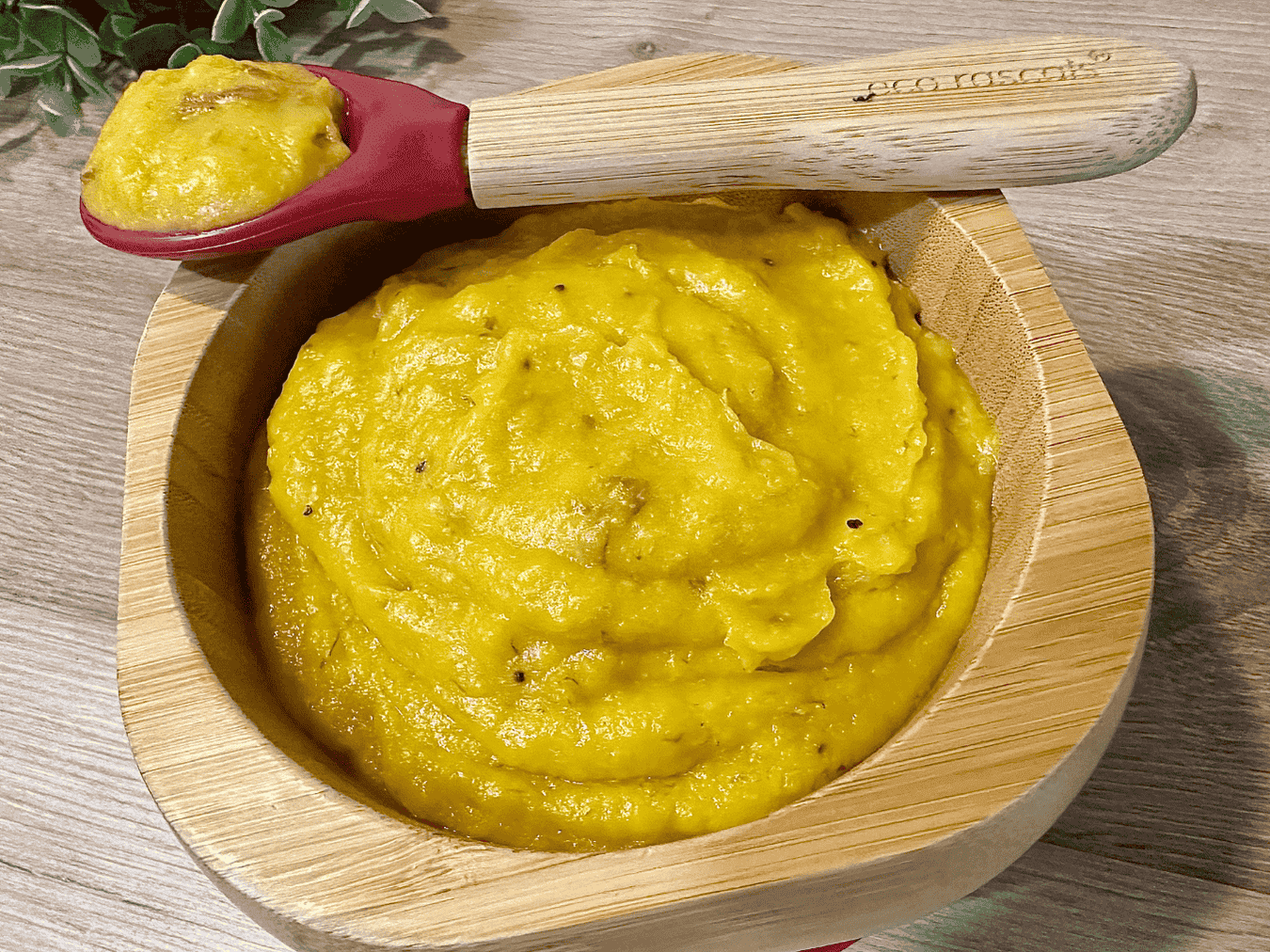
Written by Kenny Ekerin
Fact Checked by Mindsmaking Professionals
24th, November, 2025
This post may contain affiliate links. Please read our disclosure policy.
A smooth, naturally sweet carrot plantain purée that's perfect for babies starting solids. Easy to make, packed with nutrients, and gentle on tiny tummies—this homemade baby food is a mealtime favorite for both little ones and parents.
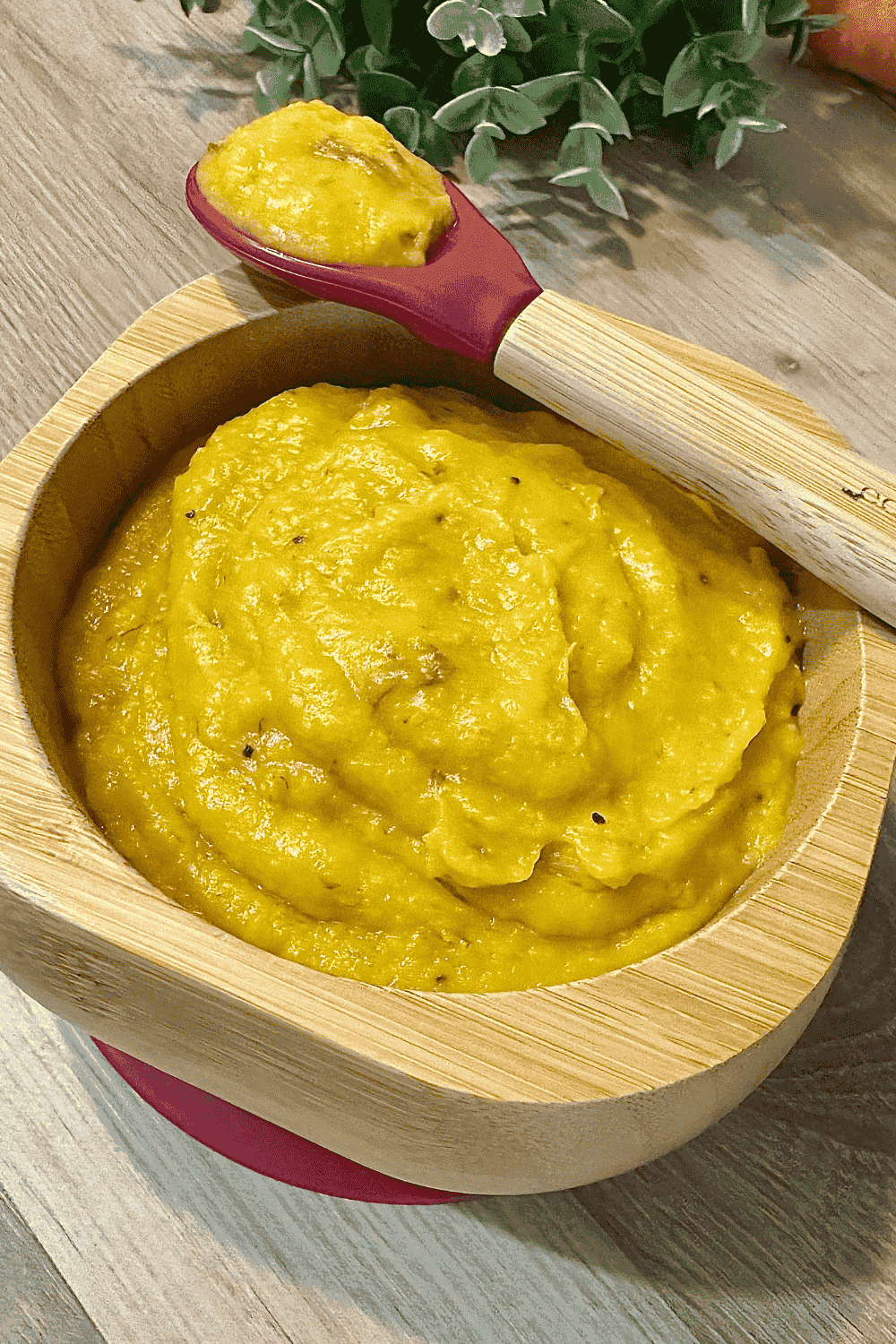
Why This Carrot Puree Is Great For Babies
This carrot plantain purée isn’t just tasty — it’s a nourishing powerhouse that’s perfect for growing babies. It combines simple, wholesome ingredients that are naturally gentle on tiny tummies, making it one of the best first foods for babies who are just starting their solids journey.
Carrots are packed with beta-carotene, which the body turns into vitamin A, an essential nutrient for healthy vision, skin, and immune development. They're also naturally sweet, which makes them a big hit with babies discovering new flavors. When paired with ripe plantains, which are full of potassium, fiber, and natural energy, you get a soft, smooth purée that’s both delicious and nutrient-rich.
Plantains also bring in a creamier texture when cooked and blended, making this homemade baby purée easy to swallow and perfect for those early stages of weaning. The small addition of spring onion adds a tiny hint of savory flavor, helping your baby get used to more complex tastes in a gentle way. And with a touch of unsalted butter, you’re adding healthy fats that support brain development and keep your little one satisfied.
Another reason parents love this recipe is that it’s so easy to make. Whether you’re new to cooking or just short on time (because who isn’t when there’s a baby in the house?), this purée comes together with minimal fuss and maximum flavor. Plus, it’s naturally free from added sugars, salt, and preservatives — a huge win when it comes to healthy baby food.
At the heart of it, this carrot plantain purée is more than just a meal — it’s a comforting, nourishing start to your baby’s lifelong relationship with food. Simple, smooth, and full of goodness, it’s a recipe you’ll keep coming back to.
Carrot Plantain Purée Recipe
Ingredients:
- 1 cup chopped carrots (peeled and cut into small chunks)
- 1 cup peeled and chopped ripe plantain (yellow with a few black spots but still firm)
- 1/3 cup chopped spring onion (white and light green parts only for a milder flavor)
- 1 1/4 cup water (add more if needed for desired consistency)
- 1 tablespoon unsalted butter (adds creaminess and healthy fats)
Mindsmakin
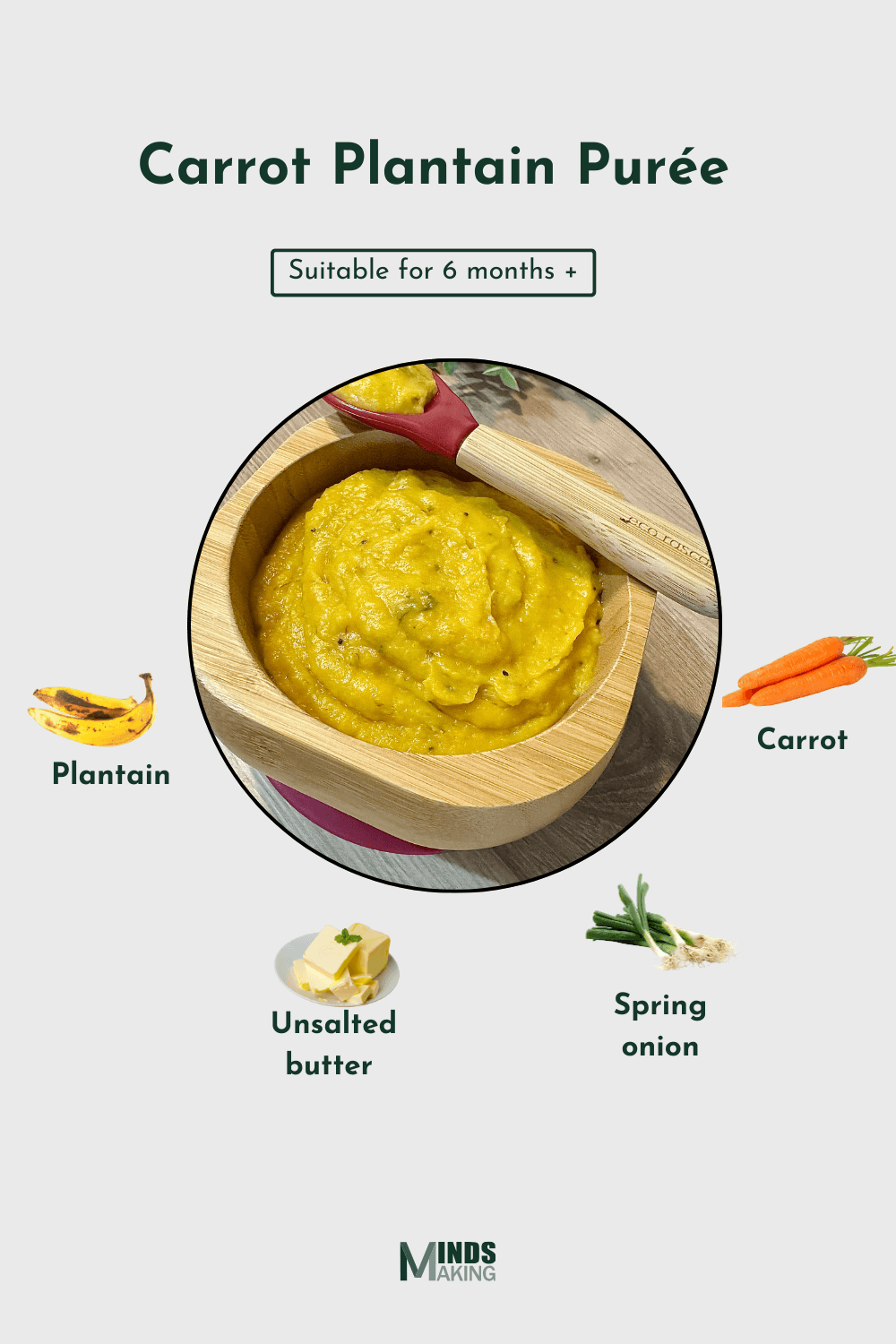
Instructions:
1. Prep the ingredients: Start by washing and peeling the carrots, then chop them into even-sized chunks. Peel the plantain (make sure it’s ripe but not too soft) and chop it into small pieces. Rinse and slice the white and light green parts of the spring onion — they bring a gentle savory flavor that babies can enjoy.
2. Cook everything together: In a medium saucepan, toss in the chopped carrots, plantain, and spring onions. Add 1¼ cups of water — just enough to slightly cover the veggies. Stir in the tablespoon of unsalted butter for a touch of richness.
Bring the mixture to a gentle boil over medium heat, then reduce the heat to low. Cover and let it simmer for about 15–20 minutes, or until the veggies are fork-tender.
Mindsmaking
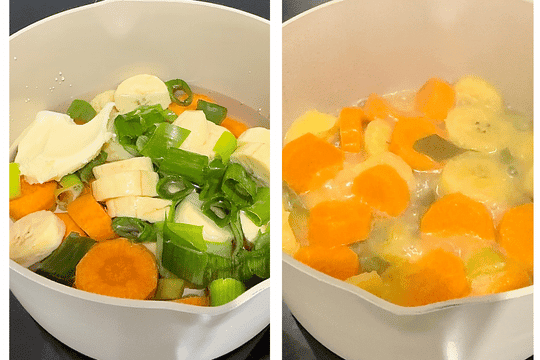
3. Blend it up: Once everything’s nice and soft, remove from the heat. You can use an immersion blender right in the pot (super convenient!), or transfer to a regular blender. Blend until smooth or leave a little texture depending on your baby’s stage and preferences.
Feel free to add more water to get the consistency just right — thinner for younger babies, or a little thicker for older ones who are used to solids.
Mindsmaking

4. Cool, serve, or store: Let the purée cool before serving — make sure it’s at a safe temperature. Serve it fresh, or store leftovers in an airtight container in the fridge for up to 3 days. You can also freeze small portions in baby-safe containers or ice cube trays for easy future meals.
Read This Next

Recipe Ebook
Essential Guide to Starting Solids for Babies 6 Months+ - LBH Top 70 Baby Puree & Porridge Recipes eBook.
Start your baby’s solids journey with confidence using this "70 Baby Purees & Porridges" eBook! Created with care, this digital guide is packed with nutrient-rich recipes for babies 6 months and older, including purees and porridges tailored to each stage of your baby’s development.
Mindsmaking
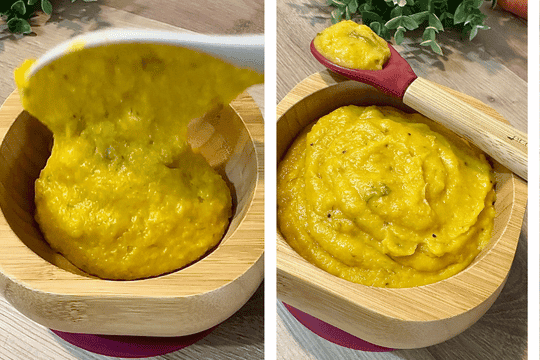
Tips for Success (Because We Know Every Baby Is Different!)
One of the best things you can do is pay attention to the texture. If your baby is just starting solids, they’ll do best with a thinner, super smooth purée. Just add a little extra water (or even breast milk or formula) while blending until you reach the right consistency for their age and stage.
Don’t be afraid to play around with the flavors as your baby gets more comfortable with solids. While this recipe is perfectly mild and naturally sweet, you can gently introduce other baby-safe ingredients later on, like a small spoonful of cooked lentils, a pinch of cumin, or even a splash of olive oil for extra healthy fats. This helps develop your little one’s palate and keeps things interesting!
If you’re big on meal prep (because let’s face it, we all need shortcuts sometimes), this recipe is ideal for batch cooking. Double the quantities and freeze the purée in baby-safe containers or ice cube trays. That way, you’ve got ready-to-go meals or mix-ins for the week ahead — just thaw and warm gently when needed. Talk about a time-saver during those busy days!
And finally, trust your instincts. Every baby is different — some might gobble this up right away, while others need a little warming up to new tastes. That’s totally normal. Keep the experience fun, mess-friendly, and low-pressure. You’re doing a great job just by offering nourishing, homemade goodness.
Serving Suggestions (Making Mealtime Easy and Enjoyable!)
This carrot plantain purée is wonderfully versatile, which makes it a great base for all kinds of baby meal ideas. For younger babies who are just starting out with solids, you can serve it as-is — warm, smooth, and mild. Just make sure it’s cooled to a safe temperature before offering it with spoon. Babies often love the natural sweetness from the ripe plantain, and the creamy texture makes it easy to swallow.
As your baby grows and starts exploring more textures, you can serve the purée slightly thicker or even mash it gently instead of fully blending. This helps ease the transition from smooth purees to more textured foods. It also pairs really well with soft grains like cooked quinoa, rice, or oats — just stir a little into the purée for a heartier meal.
If you're looking for baby food combinations, try mixing this purée with a spoonful of plain, full-fat yogurt or lentils for extra protein and creaminess. A little swirl of mashed avocado or butternut squash can also add variety and nutrients while still keeping it baby-friendly.
For families doing a more flexible approach to weaning, this purée can double as a nutritious dip for soft finger foods like steamed carrot sticks or bread strips for older babies who are self-feeding. It’s also a wonderful side dish to accompany a small portion of soft scrambled egg or fish once you’ve introduced those foods safely.
At the end of the day, mealtime doesn’t have to be complicated. This simple purée gives you a wholesome, tasty option that fits beautifully into your baby’s feeding journey, whether it’s a standalone meal or part of a bigger baby-friendly plate.
How to store ( Life’s Easier with a Little Prep!)
Once you've blended the purée and let it cool to room temperature, you can pop any leftovers into an airtight container and store it in the fridge. It will stay fresh there for up to 3 days, which is ideal for planning ahead without wasting any of that baby-loving goodness.
If you’ve made a larger batch or want to prep for the week (or even the month!), freezing is your best friend. Simply spoon the purée into baby-safe containers or ice cube trays, cover well, and freeze. Once frozen, you can transfer the cubes into a freezer-safe bag or container to save space. Each cube is a perfect portion size, especially for early feeding stages, and you can thaw only what you need.
When you're ready to use the frozen purée, you can defrost it overnight in the fridge or gently warm it in a small saucepan on the stove. A quick swirl in a bowl placed over warm water works great, too. Just be sure to stir well and always check the temperature before serving it to your little one — it should be warm, not hot.
And like with all homemade baby food, avoid refreezing purée that’s already been thawed, and toss out any leftovers from your baby’s plate to keep things safe and hygienic. With just a little prep, you’ll have nutritious meals on hand anytime, without the stress.
Nutrition Guide
Suitable for 6 months +
Per serving, approximate)
- Calories: 120–150 (mainly from plantain and butter)
- Protein: 1–2g (from vegetables and butter)
- Healthy Fats: 4–5g (from unsalted butter)
- Carbohydrates: 20–25g (from plantain and carrots)
- Fiber: 3–4g (from carrots and plantain)
- Vitamin A: high, from carrots
- Vitamin C: from carrots and plantain
- Potassium: from plantain
- Iron: small amounts from carrots
- Calcium: trace amounts from butter
Note: Nutritional values are estimates and may vary based on ingredient brands and portion sizes.
Frequently Asked Questions
What age is this purée suitable for?
This purée is perfect for babies starting solids around 6 months, depending on readiness. It’s smooth, gentle, and made with baby-safe ingredients — great for first tastes.
Is plantain safe for babies?
Yes! When cooked until soft and ripe (yellow with black spots), plantains are gentle on digestion and packed with nutrients like potassium and fiber. Just make sure they’re fully soft and blended.
My plantain is too green — can I still use it?
For this purée, ripe plantains (yellow with some black spots) are best. Green plantains are firmer and starchier, which won’t give you the soft, naturally sweet texture this recipe calls for.
Can I skip the spring onion?
Yes, especially for younger babies or if you’re introducing one ingredient at a time. The spring onion adds a gentle savory note, but it’s totally optional.
What’s the purpose of the butter?
Unsalted butter adds healthy fats for brain development and helps create a smooth, creamy texture. You can skip it if preferred, or swap for a splash of olive oil or avocado oil.
Can I make this purée without butter for a dairy-free version?
Definitely! Just leave it out or use a baby-safe oil like olive oil or coconut oil. The texture will still be smooth and nourishing.
What if my purée is too thick?
No problem! Simply stir in extra water, breast milk, or formula until you reach the desired consistency — especially important for younger babies who need thinner textures.
Can I add other ingredients to this purée?
Yes — once you’ve introduced the core ingredients safely, you can try: A spoonful of cooked lentils for protein A bit of cooked quinoa or rice stirred in A swirl of plain yogurt, mashed avocado, or butternut squash A tiny pinch of baby-safe spices like cumin or cinnamon
How long does this purée last in the fridge?
Store leftovers in an airtight container in the fridge for up to 3 days.
Can I freeze this purée?
Yes! Freeze in baby-safe containers or ice cube trays. Once frozen, transfer cubes to a freezer-safe bag or container. They’ll keep for up to 3 months.
How do I thaw and reheat frozen purée?
Thaw overnight in the fridge or warm gently on the stove or in a bowl over warm water. Always stir well and test the temperature before serving to your baby.
Can this purée be made ahead for batch cooking?
Definitely! It’s ideal for meal prep. Make a big batch, freeze in portions, and you’ll always have baby food ready when you need it.
What texture should I aim for?
For younger babies (6–7 months): blend smooth and thin with extra liquid For older babies (8–10+ months): leave a little texture or mash instead of fully blending
Can I use a food processor or a regular blender?
Yes! An immersion blender, food processor, or countertop blender will all work well — just blend until the texture suits your baby’s stage.
Can older babies eat this as a dip or mixed with other foods?
Totally! Use it as a: Dip for steamed veggie sticks or soft bread Mix in with soft grains like quinoa or oatmeal Side for scrambled egg, fish, or tofu (once introduced)
What’s the benefit of using carrots in baby food?
Carrots are rich in beta-carotene (vitamin A) for healthy vision and immune support. Plus, babies love their natural sweetness!
Can I reuse leftovers from my baby’s plate?
No — always discard leftovers that have been in contact with your baby’s spoon or mouth to avoid contamination.
What should I do if my baby doesn't like the purée right away?
That’s normal! Keep offering it in a low-pressure way. Babies often need multiple exposures to get used to new flavors and textures.
Was this article helpful?
How many stars are you giving this article?
Leave a comment
Your email address will not be published.
Comments
More From Recipe

Chocolate Smoothie Chia Pudding

Coconut Chocolate Waffle Pops
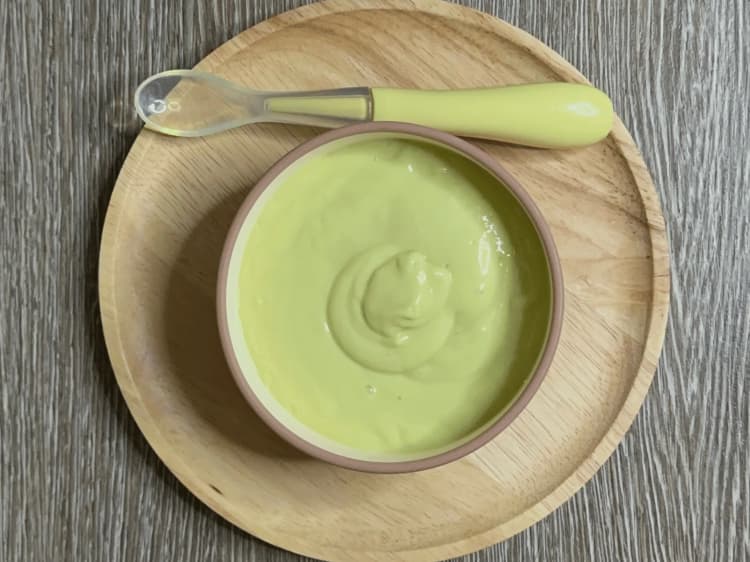
Mango & Avocado puree
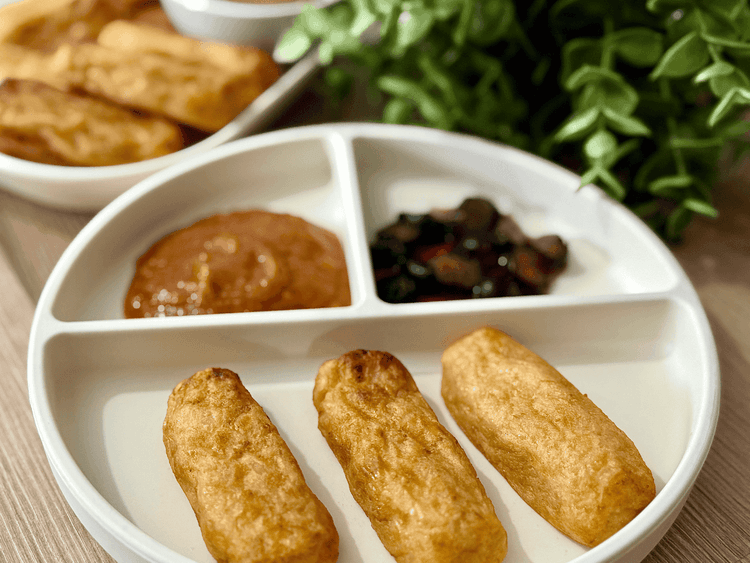
Easy Cauliflower Tots

Sweet Potato Oats Porridge

Avo, Carrot & Prune Puree
Get new recipes to your inbox
Subscribe to our weekly newsletter and get new recipes sent to your inbox!